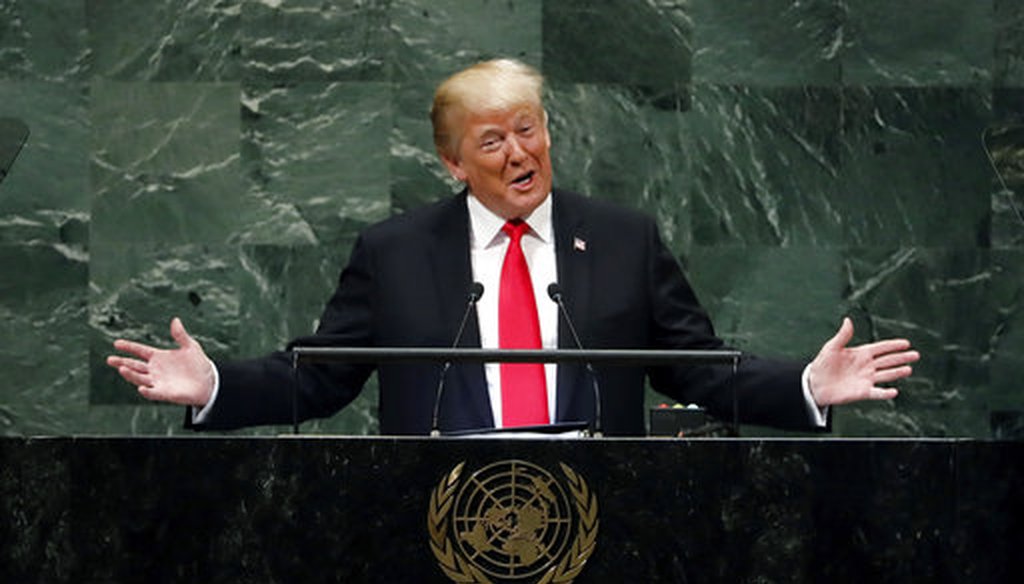Get PolitiFact in your inbox.

President Donald Trump addresses the 73rd session of the United Nations General Assembly, at U.N. headquarters, Sept. 25, 2018. (AP Photo/Richard Drew)
President Donald Trump appealed to world leaders to cooperate on areas of mutual interest during his speech at the United Nations General Assembly, while reinforcing the "America First" ethos Trump has touted since first hitting the 2016 campaign trail.
"We reject the ideology of globalism," Trump said, "and we embrace the doctrine of patriotism."
Trump touched on North Korea, Iran and national security in a wide-ranging address Sept. 24. Here’s our review of some of his claims.
North Korea has taken "encouraging measures" since Trump’s summit with Kim
This claim requires more context.
Since Trump and North Korean leader Kim Jong Un met in Singapore in June, Pyongyang has apparently halted nuclear testing, as well as its practice of firing ballistic missiles, which had rattled neighbors and the international community. Trump also pointed to the dismantlement of some North Korean military facilities as a marker of progress in the ongoing negotiations.
But North Korea is still operating its well-known nuclear facility at Yongbyon. There’s also evidence of additional uranium enrichment occurring at secret facilities.
A month after the Trump-Kim summit, researchers at the Middlebury Institute, which focuses on nuclear nonproliferation, disclosed what it believes to be a covert uranium-enrichment facility at Kangson.
Trump’s Secretary of State Mike Pompeo also noted at a Senate Foreign Relations Committee hearing in July that North Korea continues to produce fissile material.
"In the years since the (Iran) deal was reached, the military budget grew nearly 40 percent."
Trump overstated the growth of Iran’s military budget in the wake of the Obama-era accord.
Under the 2015 nuclear deal, Iran scaled back its nuclear program in exchange for relief from crippling sanctions. The lifting of U.S. and European sanctions kicked in in 2016.
According to the Stockholm International Peace Research Institute, Tehran’s military spending grew from $10.8 billion in 2015 to $14.1 billion last year — an increase of about 30 percent.
Another estimate, from the nonpartisan Congressional Research Service, found higher defense spending levels, as well as a slightly higher percentage increase since the deal was brokered. Still, the military spending numbers were lower than those Trump cited.
"Not long ago, Venezuela was one of the richest countries on Earth."
Venezuela’s economic collapse, hyperinflation and widespread starvation are well known. But is it true that not long ago it was one of the richest countries in the world?
"I think calling it one of the richest countries on earth is a stretch," said Dany Bahar, a fellow at the Brookings Institution.
In the late 1960s, Venezuela’s GDP per capita was comparable with high income countries, he said. And in the ‘70s and even ‘80s, it was among the richest countries in Latin America.
"But it was still considered a middle-income country by the World Bank, never an upper-income one such as U.S., Britain, France and others," said Shannon O'Neil, a Latin America expert at the Council on Foreign Relations.
"Per-capita income never grew to levels seen in Spain or Portugal, the lower-income level European nations," she added. "It also has always had a significant percent of people living in poverty."
Going back further in time, Venezuela by some measures was the fourth-richest country in the world on a GDP per capita basis in 1950, said Harold Trinkunas, a Stanford University researcher and Latin America expert.
But that was "compared to countries whose economies had been devastated by World War II," he said. "Once Europe and Japan recovered, Venezuela quickly fell out of the top rankings many decades before Chavez or Maduro were on the scene."
"The United States is the largest giver in the world by far of foreign aid."
Based just on the dollar amounts, Trump is correct about the United States, the world’s largest economy. Based on the size of the economy, more than 20 nations are more generous.
Looking at dollar amounts provided in 2016, the latest year for this comparison in the Organization for Economic Cooperation and Development database, the United States topped all other nations at $28.5 billion. Germany came in second with $19.6 billion, and the United Kingdom was third with $11.5 billion.
But relative to each country’s economy, the United States ranked 25th out of 39. In 2017, it gave 0.18 percent of its gross national income (the OECD’s economic yardstick). The United Arab Emirates were in the No. 1 slot with 1.31 percent, followed by Sweden at 1.01 percent and Luxembourg at 0.99 percent.
Based on the U.S. State Department’s narrower definition of economic development assistance, the amounts of foreign aid have trended lower since 2015, falling from $9.7 billion to $2 billion in 2018.
"The United States lost over 3 million manufacturing jobs ... and 60,000 factories after China joined the WTO."
When China joined the World Trade Organization and the United States gave China permanent normal trade relations status, it removed significant barriers to trade and investment with China, basically putting them on an even playing field with the United States’ other trading partners.
The first part of Trump’s assertion, on manufacturing jobs, is actually an understatement on the number of jobs. Official data shows that the manufacturing sector has shrunk by almost 4.4 million jobs since 2001, the year China joined the World Trade Organization.
As for factories, we have looked at a U.S. Census Bureau database called Business Dynamics Statistics. It tallied 348,513 manufacturing establishments in 2001 and 274,756 in 2014, the most recent year available. That’s a drop of 73,757 manufacturing establishments.
Not all of these losses were due to China — automation has certainly played a role as well.
"We have secured record funding for our military — $700 billion this year and $716 billion next year."
The major spending bill earlier this year raised the defense budget -- the combination of the base defense budget and the amount for overseas operations -- to $700 billion in fiscal year 2018 and to $719 billion in fiscal year 2019. (Trump was off by a few billion in the U.N. speech.)
Trump has a point that the military is set to spend a near-record amount of raw dollars in 2018 and 2019 (though it was a bit higher in 2010 and 2011). This, however, is largely due to inflation and the nation’s increasing gross domestic product. The nation regularly sets new benchmarks in absolute amounts of defense spending.
To make year-to-year comparisons, economists often use a different metric — defense spending as a percentage of gross domestic product. There is no GDP data yet for 2018 and 2019, but here’s a chart showing defense spending as a percentage of GDP back to 1962.
In 2017, the last year available, military spending accounted for just over 3 percent of GDP. By comparison, it ranged from 7 percent to 9 percent in the 1960s and was as high as 4.7 percent as recently as 2010.
Our Sources
Speech by Donald Trump at the United Nations General Assembly, Sept. 25, 2018
Email interview with Kelsey Davenport, the director for nonproliferation policy at the Arms Control Association, Sept. 25, 2018
Email interview with Dany Bahar, a fellow at the Brookings Institution, Sept. 25, 2018
Email interview with Shannon O'Neil, a Latin America expert at the Council on Foreign Relations, Sept. 25, 2018
Email interview with Harold Trinkunas, a Stanford University researcher and Latin America expert, Sept. 25, 2018
Email interview with Todd Harrison, director of defense budget analysis at the Center for Strategic and International Studies, Sept. 25, 2018




 PolitiFact Rating:
PolitiFact Rating: 
 PolitiFact Rating:
PolitiFact Rating:  PolitiFact Rating:
PolitiFact Rating:  PolitiFact Rating:
PolitiFact Rating: 


















































